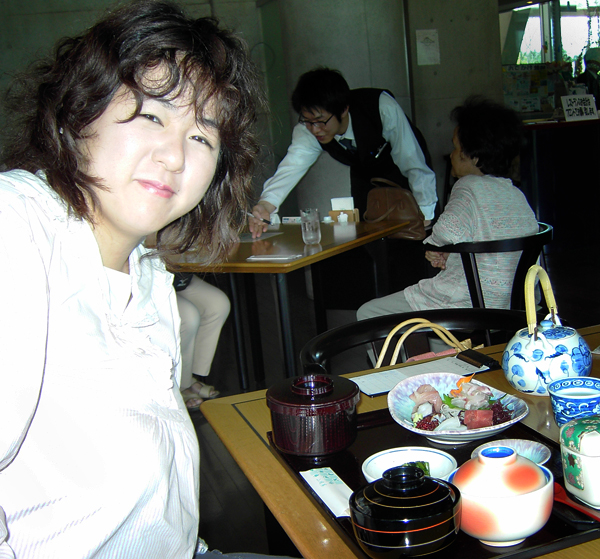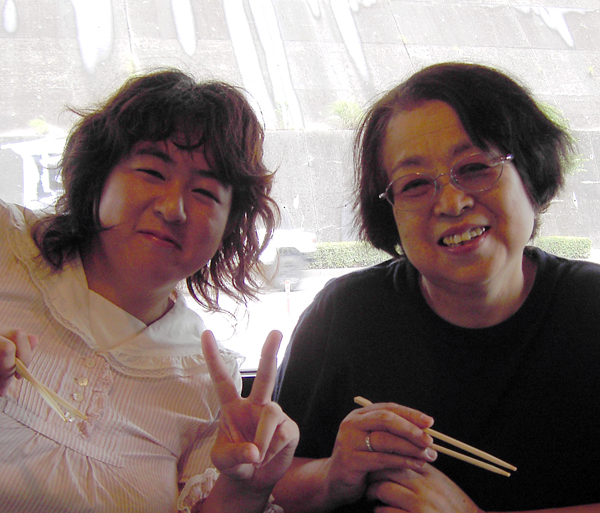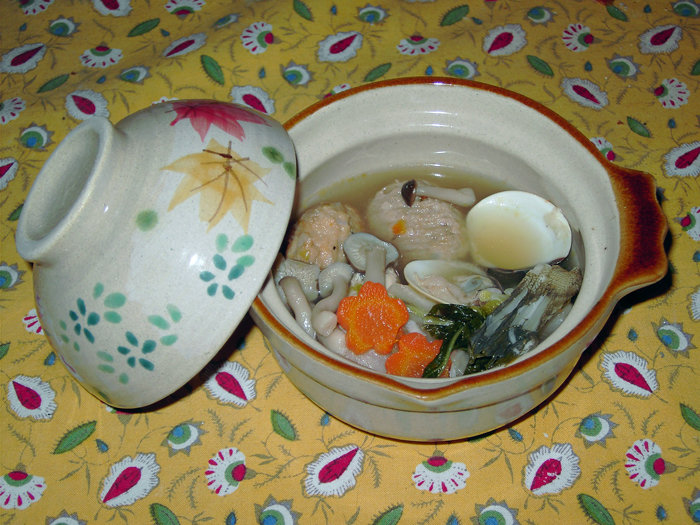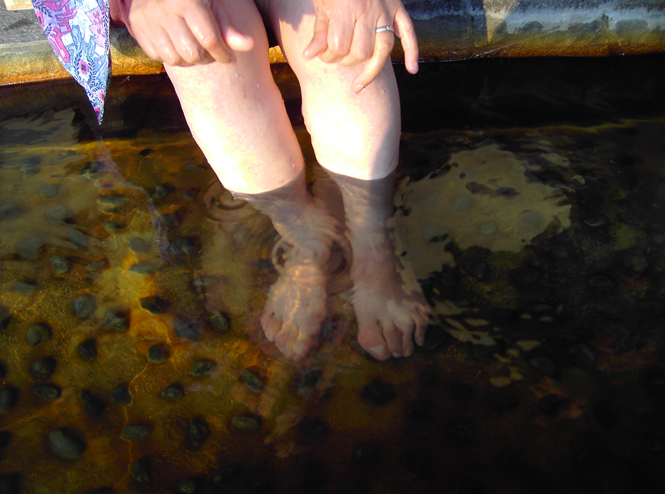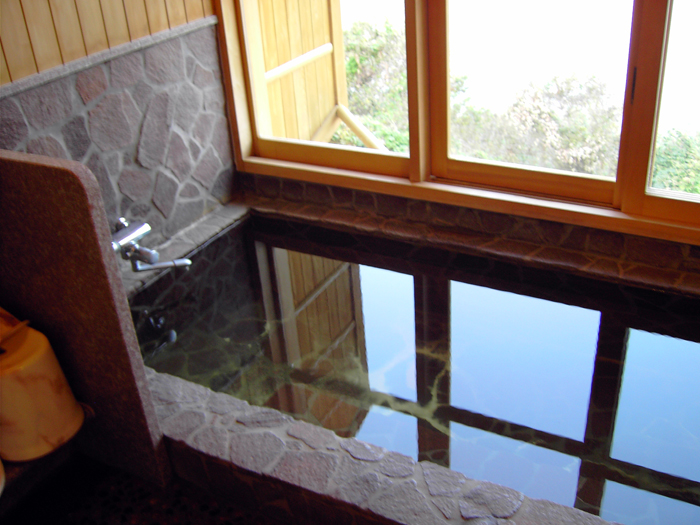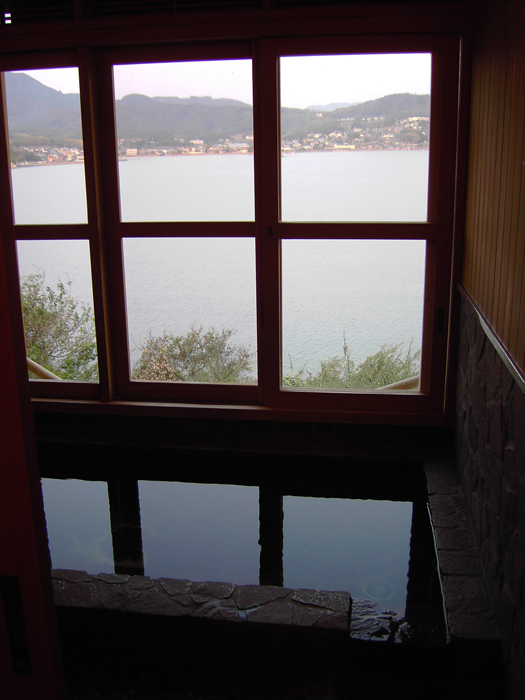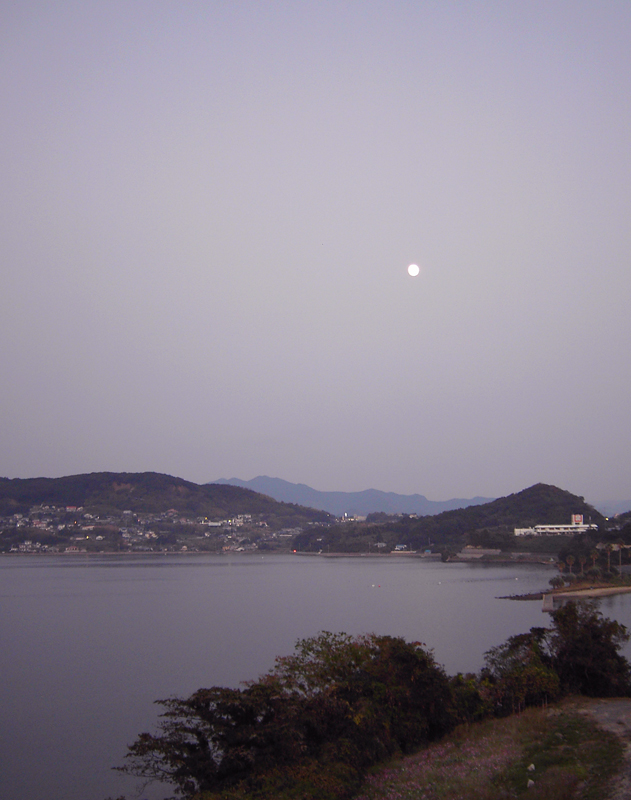 I took the free shuttle from the base to the airport last Tuesday morning, and flew to Okinawa to visit my cousin Emily. Though I'd packed summer shirts and skirts, I was kind of stupid and wore a black tunic and dark pants for travelling. Okinawa was HOT! Em picked me up at the airport and immediately took me out sightseeing.
I took the free shuttle from the base to the airport last Tuesday morning, and flew to Okinawa to visit my cousin Emily. Though I'd packed summer shirts and skirts, I was kind of stupid and wore a black tunic and dark pants for travelling. Okinawa was HOT! Em picked me up at the airport and immediately took me out sightseeing.I was fascinated by the differences between Okinawa and the mainland. It's MUCH flatter, of course, and much warmer. The air is ocean-scented, and there are glimpses of incredibly beautiful turquoise water here and there. Flowers are EVERYWHERE, even though it's November. Em said that in the spring and summer, the flowers are astonishing. I was pretty astonished at the November abundance of vast masses of vividly-colored hibiscus, bouganvillea, cosmos, and many other flowers whose name I didn't know. The buildings are relatively low, and are boxy and square and mostly concrete. They're mostly painted in "Key West" colors -- lots of white trimmed in coral, peach, teal and pale turquoise. One reason t
 here are so many concrete buildings (as opposed to the many wooden buildings in Sasebo) is due to the almost total razing of the island during WWII.
here are so many concrete buildings (as opposed to the many wooden buildings in Sasebo) is due to the almost total razing of the island during WWII.We went to a lacquerware factory first, which was totally cool. I had no idea what lacquerware really was until now. The various dishes, cups, platters and bowls are carved in single pieces from light, strong dried wood. Then the wood is coated with lacquer, which is made from several things, including powdered turban shells found in Okinawan waters. The lacquerware is almost all black and maroon -- very traditional. Some is left plain, some is painted, some has designs of mother-of-pearl inlaid into the lacquer, some has designs in relief on it. The relief pieces are made by rolling out a very thin "dough" of lacquer paste of a single color. The design is cut out of the "dough" and pressed onto the lacquerware piece. Details are pressed into the dough while it is still moist. Some designs are simple -- a red hibiscus blossom with green stem and leaves and a yellow stamen -- and other designs are really complex -- a landscape with trees,
 mountains, houses, etc. in many different colors. The design is pressed and rolled once it's put on the bowl or platter or whatever, so the edges are rounded and it seems part of the piece, not laid on afterwards. It was all really amazing, and now I'm really afraid I might have given away or thrown away good lacquerware, thinking it was plastic! I did buy two soup bowls (plain black with maroon interiors, no designs) and two pairs of chopsticks (both black with painted designs--Fearless Husband's with cranes, mine with wisteria blossoms). NOT cheap, but they are lovely artisanal pieces we'll use and treasure. I ACHED for a delicate lacquerware ceremonial tea set, and for an inlaid "family-sized" bento for picnicking...but both were FAR outside my price range.
mountains, houses, etc. in many different colors. The design is pressed and rolled once it's put on the bowl or platter or whatever, so the edges are rounded and it seems part of the piece, not laid on afterwards. It was all really amazing, and now I'm really afraid I might have given away or thrown away good lacquerware, thinking it was plastic! I did buy two soup bowls (plain black with maroon interiors, no designs) and two pairs of chopsticks (both black with painted designs--Fearless Husband's with cranes, mine with wisteria blossoms). NOT cheap, but they are lovely artisanal pieces we'll use and treasure. I ACHED for a delicate lacquerware ceremonial tea set, and for an inlaid "family-sized" bento for picnicking...but both were FAR outside my price range.Then Em took me to the Ryukyu Glass Factory. She sent me a clear oval glass plate with a swirl of cobalt and sky blue in it a couple of months ago from this
 particular factory, and I was really looking forward to seeing the place. The outside of the building, including the big support pillars and the wall along the walkway and stairs, was totally covered in vividly colored clear glass bricks. It was lovely! The glass blowing had stopped for the day, which was so very disappointing, but we did see some of the glass furnaces roaring away. Two of the artisans invited us into their work area so we could peer into the annealing kiln and see all the newly made vases and bowls slowly cooling down (if they cooled in the open air, the surface glass would cool faster than the
particular factory, and I was really looking forward to seeing the place. The outside of the building, including the big support pillars and the wall along the walkway and stairs, was totally covered in vividly colored clear glass bricks. It was lovely! The glass blowing had stopped for the day, which was so very disappointing, but we did see some of the glass furnaces roaring away. Two of the artisans invited us into their work area so we could peer into the annealing kiln and see all the newly made vases and bowls slowly cooling down (if they cooled in the open air, the surface glass would cool faster than the  inner glass, and the pieces would shatter). We had a great time in the huge shop, and I had to restrain myself from buying everything I saw! The glass industry in Okinawa started with Okinawans melting down the many, many soda bottles left by the American forces. At first, the pieces were utilitarian (like the well-known glass floats for fishing nets), but the craftsmen began to make pieces with vivid colors, and branched into more decorative work. Most of it is thick, and much of it has bubbles in the glass. It reminded me a little bit of Mexican glass, but with a much larger range of colors and shapes.
inner glass, and the pieces would shatter). We had a great time in the huge shop, and I had to restrain myself from buying everything I saw! The glass industry in Okinawa started with Okinawans melting down the many, many soda bottles left by the American forces. At first, the pieces were utilitarian (like the well-known glass floats for fishing nets), but the craftsmen began to make pieces with vivid colors, and branched into more decorative work. Most of it is thick, and much of it has bubbles in the glass. It reminded me a little bit of Mexican glass, but with a much larger range of colors and shapes.  I bought a set of four coasters for me and FH, a lemon-yellow glass trimmed in bright green to add to my collection, and a couple of Christmas gifts. On our way out, we went to the "factory seconds" discount store, so Emily could play the "ping pong ball game." For 300 yen (about $2.50) one is given five ping pong balls to toss into a wooden pen filled with glass pieces. If a ping pong ball lands in a piece, you "win" that piece! Em claims to have "won" several pieces. Of course, I had to tease her about how "free" were the pieces -- how many times did she have to pay 300 yen to get all the "free" glass? While I was with her, she did win two pieces and spent only 600 yen, which pleased her very much. I tossed five ping pong balls of my own, but won nothing. As a consolation prize, one is given a little tube of clear glass with a flattened center, to use as a chopstick rest.
I bought a set of four coasters for me and FH, a lemon-yellow glass trimmed in bright green to add to my collection, and a couple of Christmas gifts. On our way out, we went to the "factory seconds" discount store, so Emily could play the "ping pong ball game." For 300 yen (about $2.50) one is given five ping pong balls to toss into a wooden pen filled with glass pieces. If a ping pong ball lands in a piece, you "win" that piece! Em claims to have "won" several pieces. Of course, I had to tease her about how "free" were the pieces -- how many times did she have to pay 300 yen to get all the "free" glass? While I was with her, she did win two pieces and spent only 600 yen, which pleased her very much. I tossed five ping pong balls of my own, but won nothing. As a consolation prize, one is given a little tube of clear glass with a flattened center, to use as a chopstick rest. We headed for Emily and Dave's house after the glass factory. They have a darling little house with a tidy yard edged in tropical plants. The house has a living room/dining room/kitchen in one big room downstairs, along with a toilet room and a bathroom/laundry room. Upstairs they have three bedroooms, one with tatami flooring. It's a little smaller than our house, but it's nicely laid out and they've done a really nice job with it. The shelves along the stairway are lined with beautiful and unusual Okinawan pieces of pottery and carving, each of which was fascinating. I was exhausted, so we stayed in that night. Em made some rice, and served the curry she'd made during her "cooking lesson" a couple of days previously. It was delicious, and I enjoyed a huge big bowlful! Molly, their little dog, and I became great friends, once I scratched behind her ears. She was very pleased that I wanted to sit on the floor with her, and it wasn't long before she was pushing herself into my lap. I slept really, really well that night!
We headed for Emily and Dave's house after the glass factory. They have a darling little house with a tidy yard edged in tropical plants. The house has a living room/dining room/kitchen in one big room downstairs, along with a toilet room and a bathroom/laundry room. Upstairs they have three bedroooms, one with tatami flooring. It's a little smaller than our house, but it's nicely laid out and they've done a really nice job with it. The shelves along the stairway are lined with beautiful and unusual Okinawan pieces of pottery and carving, each of which was fascinating. I was exhausted, so we stayed in that night. Em made some rice, and served the curry she'd made during her "cooking lesson" a couple of days previously. It was delicious, and I enjoyed a huge big bowlful! Molly, their little dog, and I became great friends, once I scratched behind her ears. She was very pleased that I wanted to sit on the floor with her, and it wasn't long before she was pushing herself into my lap. I slept really, really well that night! In the morning, we took our time getting going. I enjoyed puttering around, checking e-mail and drinking coffee. We finally got moving (poor Em, dealing with my slow start!) and we drove around looking at all the gorgeous flowers and getting glimpses of the turquoise waters. Em drove us by "Okinawan Hollywood" complete with a miniature "Hollywood" sign on the hillside and several big resort hotels. It seems one twenty-minute scene from an American movie was once filmed on that stretch of beach, thus it was considered "famous" by the locals!
In the morning, we took our time getting going. I enjoyed puttering around, checking e-mail and drinking coffee. We finally got moving (poor Em, dealing with my slow start!) and we drove around looking at all the gorgeous flowers and getting glimpses of the turquoise waters. Em drove us by "Okinawan Hollywood" complete with a miniature "Hollywood" sign on the hillside and several big resort hotels. It seems one twenty-minute scene from an American movie was once filmed on that stretch of beach, thus it was considered "famous" by the locals!  We then went to Ryukyu Mura, which is sort of a replica of a pre-war Okinawan village. There were thatched-roofed huts (including the Holy House, above, guarded by the clay shisa dogs, and covered in fluttering strips of paper upon which were written prayers), lively aisa dancing with drums (see the video at the bottom!), sanshen playing (a three-stringed instrument with the round "banjo-head" part made of snake skin--see the video at the bottom!), weaving demonstrations (one could pay to learn to weave their patterns if one wanted to), Okinawan tea, pancakes and doughnuts (tea = yum, pancakes = ok, doughnuts = greasy balls of sawdust -- YUCK!) a pottery factory, a
We then went to Ryukyu Mura, which is sort of a replica of a pre-war Okinawan village. There were thatched-roofed huts (including the Holy House, above, guarded by the clay shisa dogs, and covered in fluttering strips of paper upon which were written prayers), lively aisa dancing with drums (see the video at the bottom!), sanshen playing (a three-stringed instrument with the round "banjo-head" part made of snake skin--see the video at the bottom!), weaving demonstrations (one could pay to learn to weave their patterns if one wanted to), Okinawan tea, pancakes and doughnuts (tea = yum, pancakes = ok, doughnuts = greasy balls of sawdust -- YUCK!) a pottery factory, a 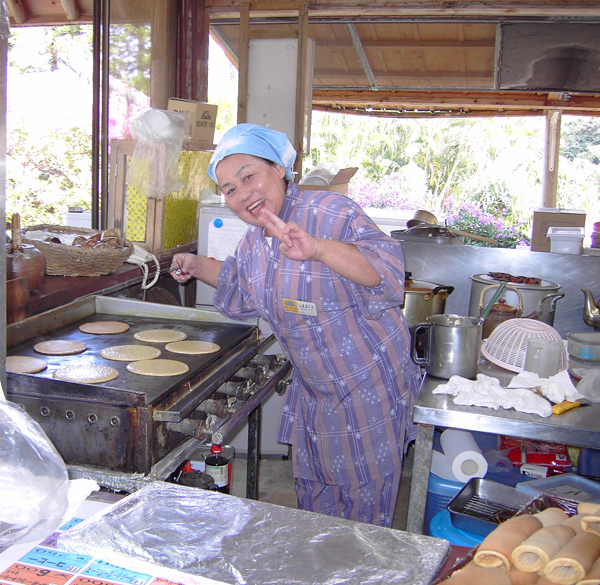 water buffalo turning the crank of an old-fashioned sugar cane press, etc. I found it all fascinating! A couple of the actor-types had on makeup, including one in the photo with Emily to the right who had drawn lines on her face to indicate wrinkles, I guess. But there were also plenty of older folks with their own home-grown wrinkles!
water buffalo turning the crank of an old-fashioned sugar cane press, etc. I found it all fascinating! A couple of the actor-types had on makeup, including one in the photo with Emily to the right who had drawn lines on her face to indicate wrinkles, I guess. But there were also plenty of older folks with their own home-grown wrinkles! The little old woman serving the tea was particularly adorable. Okinawans are some of the longest-lived people in the whole world, and this little granny was in her 80s, but spry and strong and cute as a button. I bought some of her tea, and she was thrilled! She stood up on the raised platform and stuck her hand
 straight out almost into Emily's sternum. Em was astonished, then realized the obachan (Japanese for old auntie -- literally "older sister") wanted to shake hands. Then the obachan turned to me--and suddenly grabbed me in one of the tightest hugs I've ever had! She kept giggling and hugging me really tightly. I have to admit, that it was my first human contact since I saw FH last, and I got a little teary-eyed! (And look at the strength in those arms around my neck!) The guy who'd been playing the sanshen came and took my camera out of Emily's hands, and snapped a photo of us. As we left, we saw some of the old "formal" dancing being performed. The women wear very vivid cotton kimono made of an Okinawan fabric called Bingata, and
straight out almost into Emily's sternum. Em was astonished, then realized the obachan (Japanese for old auntie -- literally "older sister") wanted to shake hands. Then the obachan turned to me--and suddenly grabbed me in one of the tightest hugs I've ever had! She kept giggling and hugging me really tightly. I have to admit, that it was my first human contact since I saw FH last, and I got a little teary-eyed! (And look at the strength in those arms around my neck!) The guy who'd been playing the sanshen came and took my camera out of Emily's hands, and snapped a photo of us. As we left, we saw some of the old "formal" dancing being performed. The women wear very vivid cotton kimono made of an Okinawan fabric called Bingata, and  huge round red "lotus" hats. The two women move in unison in very, very slow, stylized movements, accompanied by sort of eerie singing and sanshen playing.
huge round red "lotus" hats. The two women move in unison in very, very slow, stylized movements, accompanied by sort of eerie singing and sanshen playing.We got a bite to eat at a Mexican place (!!) and talked a bunch...then headed to the beach. Near the beach were two "croquet courts", both filled with elderly folks playing a game with mallets, wire hoops and hard wooden balls, on a neatly-trimmed, rolled-flat grassy expanse. The equipment and manner of play looked identical to the croquet game we know, but the wicket pattern was completely different, and I guess the rules are entirely different as well. Em said there were courts like this all over the island, and that several times a week, the elderly played this game. We nodded and smiled to several folks, and exchanged greetings with a few. One old man wanted to know if we were interested in croquet...then rather than accept our
 assurances that we did find it interesting, he shook his head and insisted we must like "baysu baru" instead! Em suspected he just wanted to say "baseball" to us, and thus the conversation. We walked down the steep steps to a little cove, and did some shell-hunting. I kept filling my hands, then having to drop some as I found even better ones! I could have beach-combed for hours! Unfortunately, I left my shells outside at Emily's, meaning to rinse them clean before packing them, and forgot them entirely! Oh well! I snapped a couple of good shots of the sunset, and we headed home to Em's house.
assurances that we did find it interesting, he shook his head and insisted we must like "baysu baru" instead! Em suspected he just wanted to say "baseball" to us, and thus the conversation. We walked down the steep steps to a little cove, and did some shell-hunting. I kept filling my hands, then having to drop some as I found even better ones! I could have beach-combed for hours! Unfortunately, I left my shells outside at Emily's, meaning to rinse them clean before packing them, and forgot them entirely! Oh well! I snapped a couple of good shots of the sunset, and we headed home to Em's house. That evening, to celebrate Dave passing his PT test, we went out to a yakiniku -- a place where you order a platter of raw meat and veggies and cook them in a grill set into the middle of the table. It was a much bigger restaurant than the yakiniku I like in Sasebo, with LOTS more choices! We took off our shoes at the door, and sat in a booth that had tatami seats at floor level, but a deeper "pit" under the table for our legs. Dave ordered for us all -- two kinds of beef, some very thin pork (sort of like bacon), Japanese mushrooms, asparagus, tomatoes, long onions, a plate of mixed veggies, and a little pot of garlic cloves in oil that we simmered on the grill until soft and delicious! We talked about ordering some seafood as well, but decided to see how full we were...and we were very glad we hadn't ordered any more food! The grill in Sasebo is gas or propane, but the grill in Okinawa used long tubes of charcoal, so the grilled flavor was very different. Of course, we each had rice as well, and lots of water. Dave also got a bottle of awamori, which is an Okinawan rice liquor. It's a lot stronger than sake, but smoother...it's poured over ice, and is 60 proof I think. You can drink it straight or mix it with water...I mixed mine with LOTS of water. It was a fantastic meal, with great food and great conversation. We had a great time, but had to finally go, as they were closing the place!
 Thursday, we got a relatively late start again -- Em thought she was waiting for me to be ready, I thought I was waiting for her. It was pretty funny! We got some Okinawan soba at Em's favorite place for breakfast/lunch. The thick soba noodles were served in a huge bowl of savory broth, with a slice of fish paste (fish sausage is what Em's Okinawan friends call it, whereas my Mainland friends call it fish paste), a slice of absolutely delicious red-cooked pork, a little lump of pork spare ribs, and a scattering of scallions. There were maybe five little bites of meat, but it was soooo good and very filling. One of the condiments on the table was a little bottle of awamori filled with tiny chiles.
Thursday, we got a relatively late start again -- Em thought she was waiting for me to be ready, I thought I was waiting for her. It was pretty funny! We got some Okinawan soba at Em's favorite place for breakfast/lunch. The thick soba noodles were served in a huge bowl of savory broth, with a slice of fish paste (fish sausage is what Em's Okinawan friends call it, whereas my Mainland friends call it fish paste), a slice of absolutely delicious red-cooked pork, a little lump of pork spare ribs, and a scattering of scallions. There were maybe five little bites of meat, but it was soooo good and very filling. One of the condiments on the table was a little bottle of awamori filled with tiny chiles.  You add it to your soba for a kicked up flavor--it gave a strong hint of the liquor, and a LOT of heat! I loved it, and may have to order some to use at honme. Then we headed to a folk museum Em liked. Even though there wasn't a whole lot of English on the display tags, there was enough to get us through. Fascinating stuff about the old ways of the Okinawans--about their textiles and agricultural ways, about their tombs shaped like wombs (circle of life!) and sunk into hillsides,how the families, even to this day have a funeral picnic in front of the "womb" as if they were sitting between the implied thighs of the earth, about the spirit houses built to hold the
You add it to your soba for a kicked up flavor--it gave a strong hint of the liquor, and a LOT of heat! I loved it, and may have to order some to use at honme. Then we headed to a folk museum Em liked. Even though there wasn't a whole lot of English on the display tags, there was enough to get us through. Fascinating stuff about the old ways of the Okinawans--about their textiles and agricultural ways, about their tombs shaped like wombs (circle of life!) and sunk into hillsides,how the families, even to this day have a funeral picnic in front of the "womb" as if they were sitting between the implied thighs of the earth, about the spirit houses built to hold the  remains of the dead (with windows for the spirits to come and go--ancient spirit houses very square and plain, more modern spirit houses made of glazed pottery and very elaborate), about their whole way of life--and both tragic information about the war, and interesting information about how innovative they were, learning to recycle and use the materials the Americans discarded, such as aluminum and glass.
remains of the dead (with windows for the spirits to come and go--ancient spirit houses very square and plain, more modern spirit houses made of glazed pottery and very elaborate), about their whole way of life--and both tragic information about the war, and interesting information about how innovative they were, learning to recycle and use the materials the Americans discarded, such as aluminum and glass.After the museum, we went to a pottery village, where a whole group of potters have set up studios and shops, and share the one huge wood-fired step-kiln. We wandered into two of the shops, and I found several things that would have made great
 Christmas gifts (including a fantastic sake bottle with a dragon that FH would have LOVED--the head was the spout, and the body looked as if it writhed in and out of the body of the pitcher) but luckily for my finances, they didn't take plastic and I didn't have enough yen to get what I wanted. The pottery was COMPLETELY different from the porcelain in my area, much more rustic, much more "hand made", a lot like the Seagrove pottery FH and I saw on our honeymoon. I really loved it! Then we went to a store that specialized in shisa, the dogs that guard everything from homes to temples to hotels. The two dogs sit on either side of the entrance (they look a lot like temple dogs, but are not the same). The male has an open mouth to capture the good spirits, and the female has a closed mouth to hold the good spirits in and protect them.
Christmas gifts (including a fantastic sake bottle with a dragon that FH would have LOVED--the head was the spout, and the body looked as if it writhed in and out of the body of the pitcher) but luckily for my finances, they didn't take plastic and I didn't have enough yen to get what I wanted. The pottery was COMPLETELY different from the porcelain in my area, much more rustic, much more "hand made", a lot like the Seagrove pottery FH and I saw on our honeymoon. I really loved it! Then we went to a store that specialized in shisa, the dogs that guard everything from homes to temples to hotels. The two dogs sit on either side of the entrance (they look a lot like temple dogs, but are not the same). The male has an open mouth to capture the good spirits, and the female has a closed mouth to hold the good spirits in and protect them.  They have tons of versions of the shisa dogs, including a fat one with a jug of awamori and an awamori cup. Em really loved that one, so I bought it as a thank-you gift for her and Dave. I also bought a pair of shisas for our house--Em is going to mail them through the free MPS, as they were far too heavy to carry home!
They have tons of versions of the shisa dogs, including a fat one with a jug of awamori and an awamori cup. Em really loved that one, so I bought it as a thank-you gift for her and Dave. I also bought a pair of shisas for our house--Em is going to mail them through the free MPS, as they were far too heavy to carry home!We were going to go to a concert given by one of Emily's friends that evening, but it was an hour's drive away, and none of us really felt like going that far. So we walked to a neighborhood izakaya, which is a Japanese
 drinking establishment with a menu of small dishes, sort of like a Japanese version of a tapas bar. They often don't open until 9 or 10 at night, and stay open until 4 or 5 in the morning! There are cubby-holes along one wall, so one can buy a bottle of awamori, then put one's name on a tag around the bottle's neck and put it in a cubby until the next visit. We sat on benches and stools made from tree-trunks, at a table made from a slab of heartwood. It was quite brightly lit, and relatively small, with perhaps six tables, two little tatami booths in an alcove, and a bar that looked right into the tiny kitchen, with perhaps five tree-trunk stools. On
drinking establishment with a menu of small dishes, sort of like a Japanese version of a tapas bar. They often don't open until 9 or 10 at night, and stay open until 4 or 5 in the morning! There are cubby-holes along one wall, so one can buy a bottle of awamori, then put one's name on a tag around the bottle's neck and put it in a cubby until the next visit. We sat on benches and stools made from tree-trunks, at a table made from a slab of heartwood. It was quite brightly lit, and relatively small, with perhaps six tables, two little tatami booths in an alcove, and a bar that looked right into the tiny kitchen, with perhaps five tree-trunk stools. On  one wall was a big salt-water aquarium, and on the other wall was a television showing a DVD of underwater scenes. The yukata-clad waitress took our order and brought us a bottle of awamori, and an ice bucket, water pitcher and three glasses, all made at the Ryukyu glass factory. We shared little platters of various snacks--some seasoned fried potatoes, some chunks of fried chicken, some great fried squid, and a platter of tofu champuru -- stir-fried cabbage, carrots, onions, and the best tofu I've ever eaten. We talked on and on, about Dave and Emily's plans after they leave, Dave's various business ideas, the possibilities of the two of them opening an izakaya in the US, etc. It was another evening of good food and great conversation.
one wall was a big salt-water aquarium, and on the other wall was a television showing a DVD of underwater scenes. The yukata-clad waitress took our order and brought us a bottle of awamori, and an ice bucket, water pitcher and three glasses, all made at the Ryukyu glass factory. We shared little platters of various snacks--some seasoned fried potatoes, some chunks of fried chicken, some great fried squid, and a platter of tofu champuru -- stir-fried cabbage, carrots, onions, and the best tofu I've ever eaten. We talked on and on, about Dave and Emily's plans after they leave, Dave's various business ideas, the possibilities of the two of them opening an izakaya in the US, etc. It was another evening of good food and great conversation.Had to get up really early Friday so Em could get me
 to the airport by 7:30am. On the way to the airport, we passed literally hundreds of people of all ages lining the streets and waving fans--teenagers, little old ladies, businessmen in suits, office ladies in tight little skirts, etc. Some had yellow headbands and yellow t-shirts, others had orange headbands and t-shirts. Each group held banners and placards proclaiming their candidate as the best...it was an election day! I've never seen so many people on the streets for an election! They streamed out of
to the airport by 7:30am. On the way to the airport, we passed literally hundreds of people of all ages lining the streets and waving fans--teenagers, little old ladies, businessmen in suits, office ladies in tight little skirts, etc. Some had yellow headbands and yellow t-shirts, others had orange headbands and t-shirts. Each group held banners and placards proclaiming their candidate as the best...it was an election day! I've never seen so many people on the streets for an election! They streamed out of  side streets, covered bridges and sidewalks, lined the overpasses, waving and smiling, exhorting voters to get out the vote! Even with all the campaigners, we got to the airport in plenty of time. Before I left, Em and Dave gave me a simply gorgeous little sake set--a pitcher and two little cups, made by one of the most famous of local potters. His kiln has been designated a national treasure, and the three ironstone pieces are simply gorgeous--rich chocolate brown with a design of leaves carved into the dark glaze to reveal the lighter clay beneath. The sake pitcher has a little pottery marble inside, which is supposed to make the sake taste better somehow, but we aren't sure exactly how!
side streets, covered bridges and sidewalks, lined the overpasses, waving and smiling, exhorting voters to get out the vote! Even with all the campaigners, we got to the airport in plenty of time. Before I left, Em and Dave gave me a simply gorgeous little sake set--a pitcher and two little cups, made by one of the most famous of local potters. His kiln has been designated a national treasure, and the three ironstone pieces are simply gorgeous--rich chocolate brown with a design of leaves carved into the dark glaze to reveal the lighter clay beneath. The sake pitcher has a little pottery marble inside, which is supposed to make the sake taste better somehow, but we aren't sure exactly how! I got back to Sasebo by 1pm, JUST in time to get picked up at the bus station by Miyuki to spend the afternoon at her school, carving Jack o' Lanterns with her ichinensei (seventh graders, literally "first year students"). Yes, Halloween was long past, but that didn't stop us! More on that interesting afternoon soon, I promise. Happy Thanksgiving to all of you...wishing you all the blessings and happiness you desire. FH should be home soon, and we hope to actually have some adventures TOGETHER for a change. Yippee!
I got back to Sasebo by 1pm, JUST in time to get picked up at the bus station by Miyuki to spend the afternoon at her school, carving Jack o' Lanterns with her ichinensei (seventh graders, literally "first year students"). Yes, Halloween was long past, but that didn't stop us! More on that interesting afternoon soon, I promise. Happy Thanksgiving to all of you...wishing you all the blessings and happiness you desire. FH should be home soon, and we hope to actually have some adventures TOGETHER for a change. Yippee!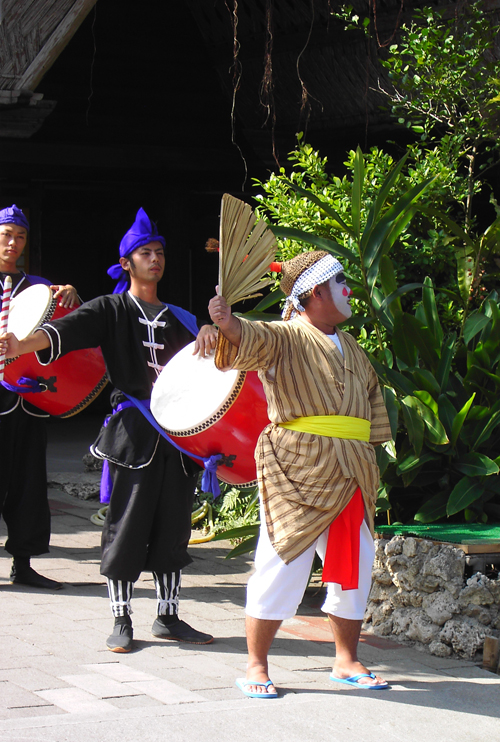

Videos (the sound isn't great--the Aisa drums played havoc with my camera's microphone!):
